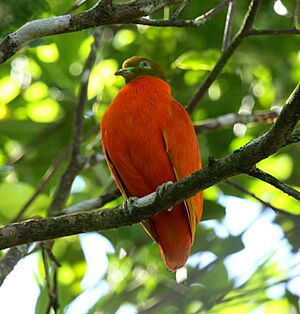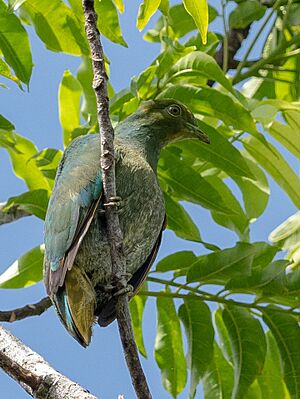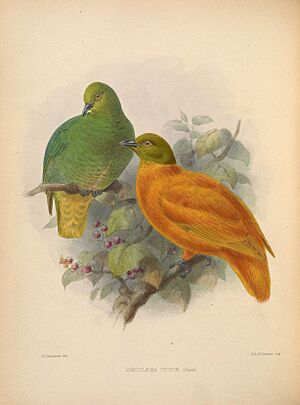Orange fruit dove facts for kids
Quick facts for kids Orange fruit dove |
|
|---|---|
 |
|
| Male at Taveuni | |
 |
|
| Female | |
| Conservation status | |
| Scientific classification | |
| Genus: |
Ptilinopus
|
| Species: |
victor
|
| Synonyms | |
|
|
The orange fruit dove, also called the orange dove, is a super colorful bird. It belongs to the pigeon family, Columbidae. The male orange fruit dove is especially striking. It has a golden-olive head and bright orange feathers that look like long hair on its body.
When the male bird is resting, its long orange wing feathers usually cover its golden-olive flight feathers. Its legs, beak, and the skin around its eyes are bluish-green. Its eyes are whitish. The female orange fruit dove looks quite different. She is a dark green bird with a blackish tail. She also has orange-yellow feathers under her tail. Young orange fruit doves look similar to the females.
This amazing bird lives only in Fiji. You can find it in the forests on islands like Vanua Levu, Taveuni, Rabi, Kioa, Qamea, and Laucala. Orange fruit doves mostly eat small fruits and berries. They also enjoy caterpillars and other insects. The female usually lays just one white egg. The orange fruit dove is related to the whistling fruit dove and the golden fruit dove. Because it is common in its home islands, experts say it is a species of least concern. This means it is not currently at risk of disappearing.
Contents
About the Orange Fruit Dove
The orange fruit dove was first described in 1872 by a scientist named John Gould. He called it Chrysoena victor. He studied birds from Vanua Levu in Fiji. The name Ptilinopus comes from ancient Greek words meaning "feather" and "foot." The name victor is Latin for "conqueror." People sometimes call this bird the orange dove or flame dove.
This bird is one of more than 50 species in the Ptilinopus group. It is very closely related to the whistling fruit dove. These two birds are also related to the golden dove. These three species are often grouped together.
Types of Orange Fruit Doves
There are two main types, or subspecies, of the orange fruit dove. Sometimes, you can find birds that are a mix of both types.
- The P. v. victor type: This type is found on Vanua Levu, Taveuni, Kioa, and Rabi.
- The P. v. aureus type: This type lives on Qamea and Laucala. Males of this type are bigger. They also have yellower wings and lighter-colored heads.
Where Orange Fruit Doves Live
The orange fruit dove lives only in Fiji. You can find it on islands like Vanua Levu, Taveuni, Kioa, Rabi, Laucala, and Qamea. Like other fruit doves, it lives in woodlands. It prefers open forests, including forests that are growing back or those along rivers. But it also lives in old, dense forests.
These doves usually live at higher elevations, between 420 and 980 meters (about 1,378 to 3,215 feet). They might not be found in lower areas because many lowland forests have been cut down.
How Orange Fruit Doves Behave
Orange fruit doves are not very social birds. They usually live alone or in pairs. Sometimes, you might see them in small groups. You might even see two females together. Once, a group of up to seven birds was seen in one tree. When they fly, they are very fast and fly straight. Their wings make a whirring sound.
What Orange Fruit Doves Eat
These doves mostly eat fruit. They like small fruits and berries that are about 4 to 7 millimeters (0.16 to 0.28 inches) wide. They have also been seen picking up insects like caterpillars from leaves. They usually look for food in the upper parts of trees, called the canopy. They also search in the lower parts, called the understory. When they find a fruit tree, the groups of doves are usually not very large.
Orange Fruit Dove Reproduction
Scientists have seen orange fruit doves nesting in June, September, November, and December. This means they probably have a long breeding season. Their nests are quite simple. They are made of a few sticks woven together. Nests are usually placed low in a tree, often about 2.5 meters (8 feet) high.
A female orange fruit dove usually lays one white egg. Sometimes, two eggs have been found. Only the female dove has been seen sitting on the eggs and taking care of the young chicks.



